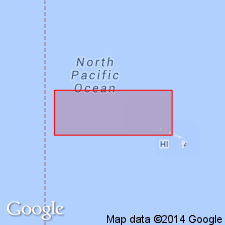
- Usage in publication:
-
- Waianae volcanic series*
- Modifications:
-
- Named
- Dominant lithology:
-
- Volcanics
- AAPG geologic province:
-
- Oahu
Summary:
Named for lava flows, intrusive rocks, (dikes) pyroclastic rocks, breccias, and intercalated soils in Waianae Range, Island of Oahu. Divided into lower, middle, and upper basalts. [No type locality designated]. Lower basalt exposed in cliffs and along lower Nanakuli Valley and Lualualei Valley, and on mountain Puu Heleakala. Middle basalt exposed continuously from head of Lualualei valley and Waianae Valley and in Keaau-Makaha Ridge. Upper basalt veneers east slopes of Waianae Range and overlies middle basalt in spurs on west side. Lower basalt is predominantly pahoehoe and is 20 to 75 ft thick except for Kuwale Ridge which has its flow topped by hornblende-biotite trachyte. Middle basalt has more aa than lower basalt. Upper basalt is characterized by massive thick (up to 2,300 ft) flows of aa. Total thickness of Waianae volcanic series is 4,025 ft above sea and probably 12,000 ft below sea level. Underlies with erosional unconformity Koolau volcanic series (new) and Quaternary sedimentary deposits. Assigned Tertiary and early Pleistocene(?) age based on erosion and unconformable relationship to later Koolau volcanic series.
Source: GNU records (USGS DDS-6; Menlo GNULEX).

- Usage in publication:
-
- Waianae volcanic series*
- Modifications:
-
- Mapped
- AAPG geologic province:
-
- Oahu
Summary:
Map description gives lithology showing dikes and tuff beds but does not differentiate the lower, middle, and upper basalt members. Age is Tertiary and early Pleistocene(?).
Source: GNU records (USGS DDS-6; Menlo GNULEX).
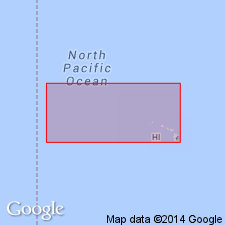
- Usage in publication:
-
- Waianae volcanic series*
- Modifications:
-
- Age modified
- AAPG geologic province:
-
- Oahu
Summary:
Stratigraphic chart shows Waianae volcanic series to be Pliocene age. Unconformably underlies Kolekole Volcanics (new) near Kolekole Pass. Kolekole Volcanics is assigned Pleistocene age.
Source: GNU records (USGS DDS-6; Menlo GNULEX).
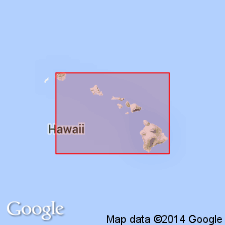
- Usage in publication:
-
- Waianae volcanic series*
- Modifications:
-
- Geochronologic dating
- AAPG geologic province:
-
- Oahu
Summary:
K-Ar ages on lava from lower member of Waianae volcanic series range from 3.31 to 2.92 Ma; from middle member range from 3.65 to 2.93 Ma; from upper member range from 2.86 to 2.73 Ma; and from Mauna Kuwale trachyte range from 8.46 to 8.26 Ma. [Author notes prolonged hiatus between eruption of trachyte and other members of series. Sample numbers. and location coordinates are given in appendix]
Source: GNU records (USGS DDS-6; Menlo GNULEX).
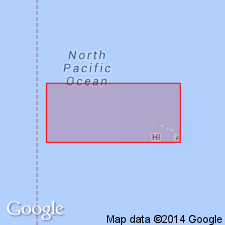
- Usage in publication:
-
- Waianae volcanic series*
- Modifications:
-
- Geochronologic dating
- AAPG geologic province:
-
- Oahu
Summary:
K-Ar ages on minerals and whole rock from rhyodacite of Mauna Kuwale [Waianae Volcanic Series] give 2.3 +/-0.3 Ma. Authors discuss reasons for anomalous old age for previous studies.
Source: GNU records (USGS DDS-6; Menlo GNULEX).

- Usage in publication:
-
- Waianae Volcanic Series*
- Modifications:
-
- Geochronologic dating
- Paleomagnetics
- AAPG geologic province:
-
- Oahu
Summary:
Paleomagnetic and K-Ar measurements "when combined with previous studies show that subaerial Waianae volcano was active only from 3.6 to 2.4 Ma." The predominantly tholeiitic lower and middle members of Waianae Volcanic Series are approximately contemporaneous and were extruded during late Gilbert [Reversed Polarity Chron] and early Gauss [Normal Polarity Chron]. They were followed by alkalic lavas of upper member probably during later part of Gauss Normal Polarity Epoch [Chron]. "Additional data on the hawaiite flow that led to the discovery of the Kaena reversed event indicate this reversed flow is 2.85 +/-0.05 m.y. old."
Source: GNU records (USGS DDS-6; Menlo GNULEX).
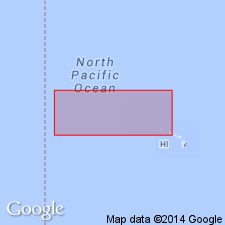
- Usage in publication:
-
- Waianae Formation
- Modifications:
-
- Revised
- AAPG geologic province:
-
- Oahu
Summary:
Waianae Volcanic Series (Stearns, IN Stearns and Vaksvik, 1935) reduced in rank and renamed Waianae Formation. "No systematic attempt is being made to revise volcanic stratigraphic nomenclature in Hawaii..."
Source: GNU records (USGS DDS-6; Menlo GNULEX).
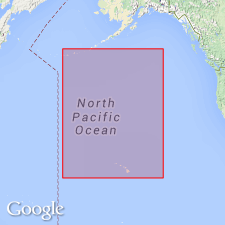
- Usage in publication:
-
- Waianae Volcanics*
- Modifications:
-
- Geochronologic dating
- AAPG geologic province:
-
- Oahu
Summary:
K-Ar ages from Lualualei and Kamaileunu Members of Waianae Volcanics (Sinton, in press) range from about 3.9 to 3.0 Ma. Ages from Palehua Member range from about 3.2 to 2.5 Ma.
Source: GNU records (USGS DDS-6; Menlo GNULEX).
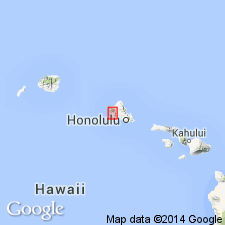
- Usage in publication:
-
- Waianae Volcanics*
- Modifications:
-
- Revised
- AAPG geologic province:
-
- Oahu
Summary:
Waianae Volcanic Series (Stearns, IN Stearns and Vaksvik, 1935) reduced in rank and renamed Waianae Volcanics to be consistent with North American Stratigraphic Code. Subdivided into 3 formally named members: Lualualei (oldest), Kamaileunu, and Palehua (youngest) Members. Kamaileunu Member includes Mauna Kuwale Rhyodacite Flow (formerly Mauna Kuwale Trachyte of McDougall, 1963). Kolekole Volcanics is geographically extended to include certain cones and flows previously included in upper member of Waianae Volcanic Series. Map gives type and reference sections for members. Unconformably underlies Kolekole Volcanics and Koolau Volcanics. K-Ar ages range from 3.8 to 2.4 Ma based on data from Doell and Dalrymple (1973) and earlier reports.
Source: GNU records (USGS DDS-6; Menlo GNULEX).
For more information, please contact Nancy Stamm, Geologic Names Committee Secretary.
Asterisk (*) indicates published by U.S. Geological Survey authors.
"No current usage" (†) implies that a name has been abandoned or has fallen into disuse. Former usage and, if known, replacement name given in parentheses ( ).
Slash (/) indicates name conflicts with nomenclatural guidelines (CSN, 1933; ACSN, 1961, 1970; NACSN, 1983, 2005, 2021). May be explained within brackets ([ ]).

